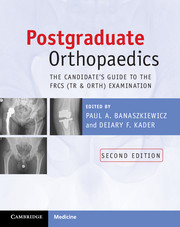Book contents
- Frontmatter
- Contents
- Contributors
- Foreword
- Preface to second edition
- Abbreviations
- Section 1 The FRCS (Tr & Orth) examination
- Section 2 The written paper
- Section 3 The clinicals
- Section 4 The adult elective orthopaedics oral
- Chapter 12 General structured oral exam guidance
- Chapter 13 Shoulder and elbow oral core topics
- Chapter 14 Hip oral core topics
- Chapter 15 Knee oral core topics
- Chapter 16 Foot and ankle oral core topics
- Chapter 17 Spine oral core topics
- Chapter 18 Orthopaedic oncology oral core topics
- Section 5 The hand oral
- Section 6 The paediatric oral
- Section 7 The trauma oral
- Section 8 The basic science oral
- Section 9 Miscellaneous topics
- Index
- References
Chapter 17 - Spine oral core topics
from Section 4 - The adult elective orthopaedics oral
- Frontmatter
- Contents
- Contributors
- Foreword
- Preface to second edition
- Abbreviations
- Section 1 The FRCS (Tr & Orth) examination
- Section 2 The written paper
- Section 3 The clinicals
- Section 4 The adult elective orthopaedics oral
- Chapter 12 General structured oral exam guidance
- Chapter 13 Shoulder and elbow oral core topics
- Chapter 14 Hip oral core topics
- Chapter 15 Knee oral core topics
- Chapter 16 Foot and ankle oral core topics
- Chapter 17 Spine oral core topics
- Chapter 18 Orthopaedic oncology oral core topics
- Section 5 The hand oral
- Section 6 The paediatric oral
- Section 7 The trauma oral
- Section 8 The basic science oral
- Section 9 Miscellaneous topics
- Index
- References
Summary
Introduction
Spine surgery is a diverse and rapidly evolving area of orthopaedics. As a career choice this makes it interesting and rewarding, but for the exam the breadth and depth of knowledge required make it a challenging area to review. There is now a requirement on examiners for the FRCS (Tr & Orth) to ask questions on spine topics, and it is unlikely that a candidate will be successful without a solid core knowledge in this area. However, the candidate has an advantage; most examiners are not full-time spine surgeons. Also, examiners are aware that most candidates are not going to become full-time spine surgeons either. Questions tend to be of one of two types. Either they are sufficiently ‘core’ that any consultant orthopaedic surgeon should know about the condition and be able to manage or refer the condition appropriately, or they are general orthopaedic questions that are being applied to the spine. In response to this increased emphasis on spine topics in the exam there are now several pre-exam spine courses being advertised (Spineclass, RCS Eng. and Cardiff). In order to cover the breadth of material required, this chapter will aim to be succinct, cover core topics in sufficient depth to ensure a pass and provide the candidate with a framework with which to tackle spine questions. Areas that will be covered include:
General knowledge
Degenerative conditions
Spinal trauma
Tumours affecting the spine
Infection and inflammation
The paediatric spine
Surgical approaches
Other miscellaneous conditions
Current areas of debate.
Structure of the intervertebral disc
There are two main components making up the intervertebral disc: the annulus fibrosus and nucleus pulposus (Figure 17.1). The annulus fibrosus is made up of concentric rings of type I collagen. Sequential layers of oblique fibres resist hoop stresses and prevent excessive movement. The nucleus pulposus forms the gelatinous core, which allows elastic deformation. Type II collagen predominates in the nucleus pulposus. In adults nutrition is via diffusion through the vertebral end-plate. In children vessels cross the end plate to the disc.
- Type
- Chapter
- Information
- Postgraduate OrthopaedicsThe Candidate's Guide to the FRCS (Tr and Orth) Examination, pp. 263 - 280Publisher: Cambridge University PressPrint publication year: 2012



